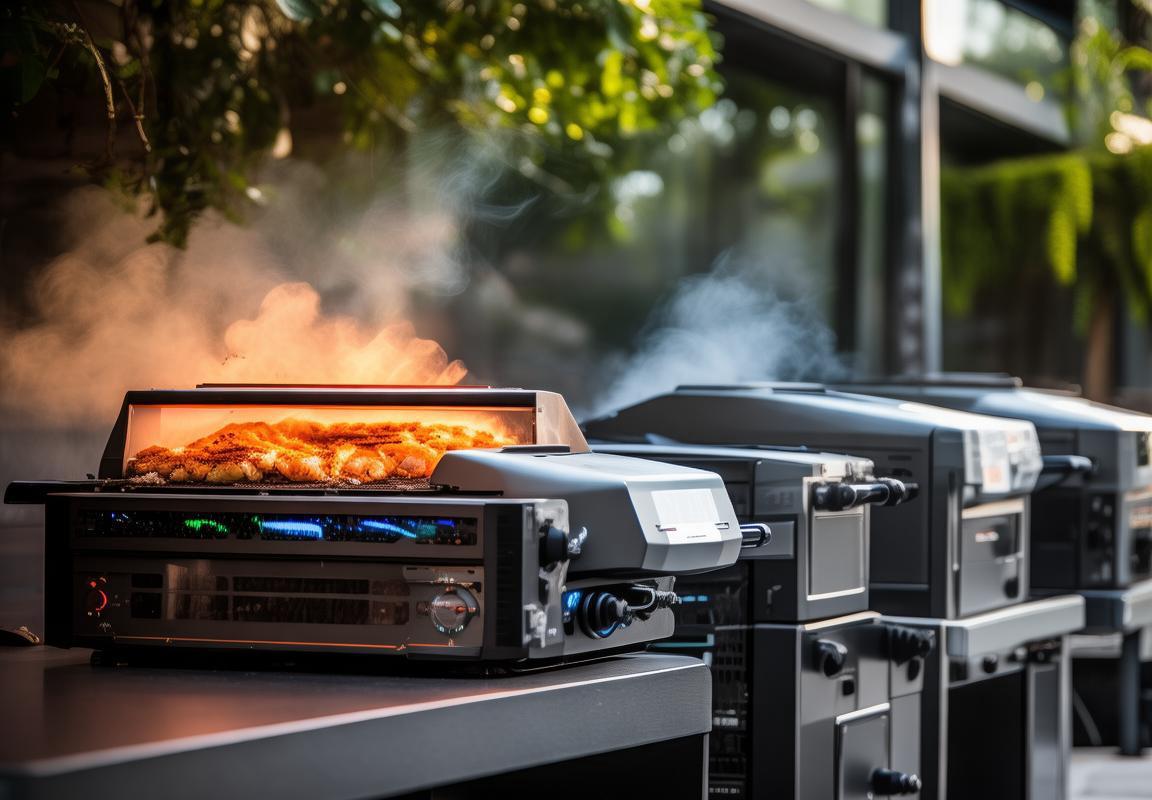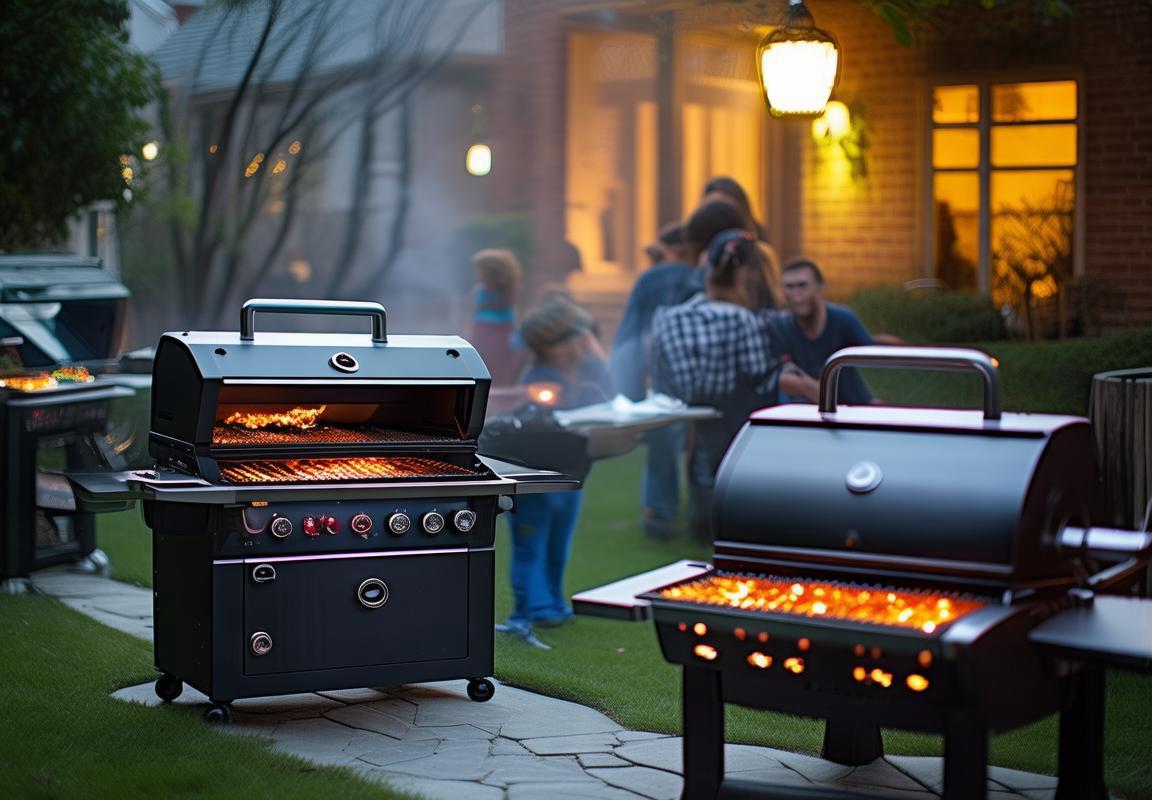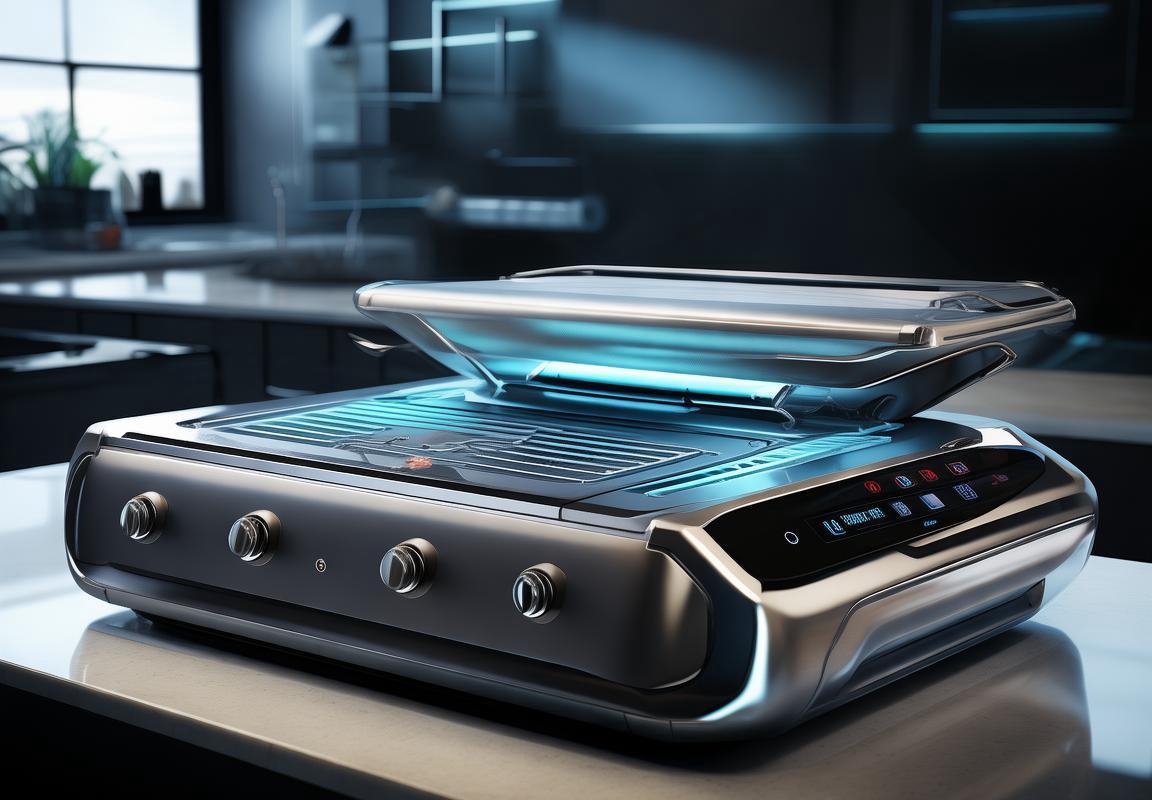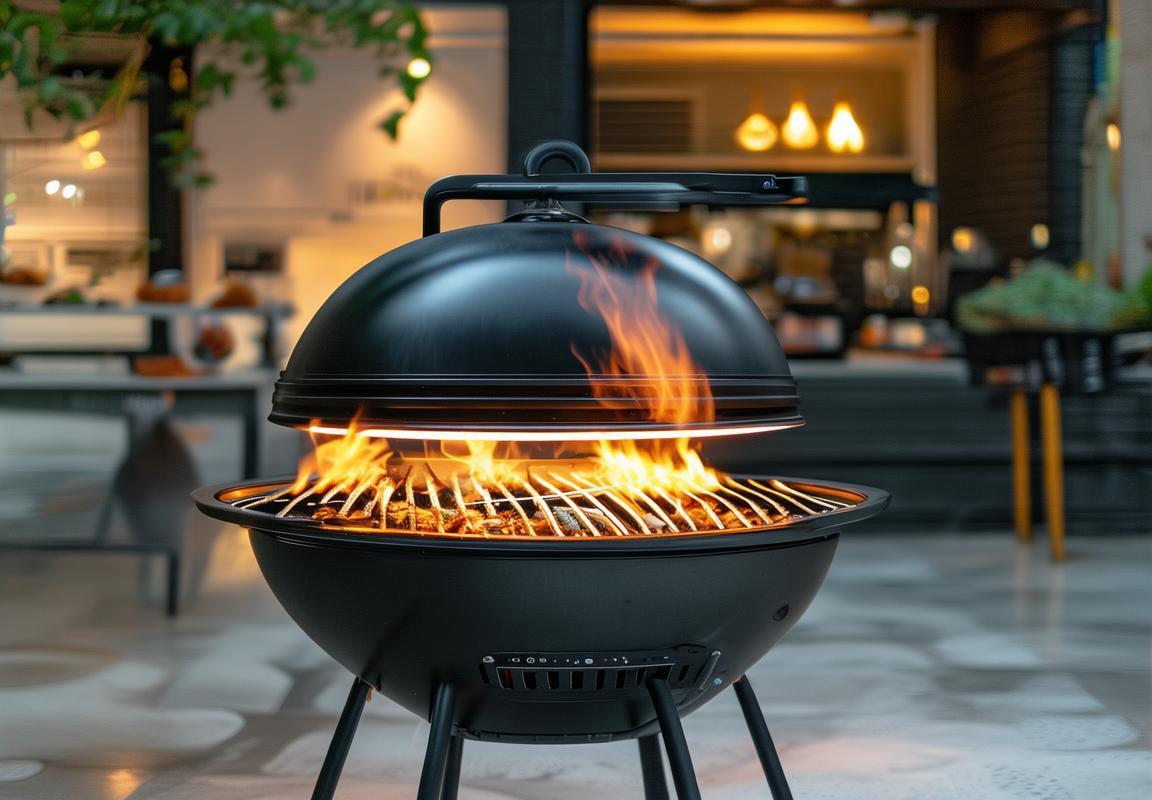In recent years, the rise of smokeless grills has revolutionized the way we enjoy outdoor cooking. This shift has not only transformed the culinary landscape but has also opened up a new frontier for the industrial sector, particularly in OEM (Original Equipment Manufacturer) manufacturing. As the demand for efficient, eco-friendly, and user-friendly smokeless grills continues to grow, understanding the market dynamics, key players, and the role of innovation becomes crucial for anyone looking to navigate this dynamic industry.
Introduction to the Smokeless Grill Market
The smokeless grill market has emerged as a beacon of innovation within the industry, offering consumers a cleaner, more convenient alternative to traditional grilling methods. As the demand for outdoor cooking experiences continues to rise, so does the interest in smokeless grills, which promise to deliver the same delicious flavors without the smoky aftermath. This market segment, though relatively new, has been rapidly growing, driven by a combination of technological advancements, changing consumer preferences, and environmental concerns.
Smokeless grills, also known as electric grills or infrared grills, utilize advanced heating elements to cook food at high temperatures without producing smoke. This technology is particularly appealing to health-conscious consumers who are looking for a way to enjoy grilled dishes without the carcinogenic compounds often found in smoke. The market for these grills is not limited to the backyard; it has expanded to include commercial kitchens, restaurants, and even portable units for camping and tailgating.
The rise of the smokeless grill market can be attributed to several key factors. First and foremost, the convenience factor is a major draw. With no need for charcoal or wood, these grills are easy to use and maintain. They also require less preparation time and offer a consistent cooking temperature, which can be a significant advantage over traditional grilling methods.
Secondly, the environmental benefits of smokeless grills cannot be overlooked. As awareness of air quality and the impact of smoke on the environment grows, consumers are increasingly seeking out products that are both efficient and eco-friendly. Smokeless grills contribute to a cleaner outdoor cooking experience, which is a compelling selling point for eco-conscious buyers.
In terms of consumer preferences, the smokeless grill market is witnessing a shift towards healthier eating habits. The perception that grilling is synonymous with unhealthy, high-fat meals is fading, and consumers are now looking for healthier alternatives that still satisfy their taste for grilled foods. Smokeless grills fit this bill perfectly, as they allow for the cooking of lean proteins and vegetables with minimal added fat.
Moreover, the market is being fueled by technological advancements. Manufacturers are continuously improving the design and functionality of smokeless grills, offering features such as adjustable temperature controls, larger cooking surfaces, and even smart technology integration. These innovations are not only enhancing the user experience but also expanding the market appeal to a broader audience.
The smokeless grill market is also seeing a surge in demand from the commercial sector. Restaurants and catering services are increasingly interested in these grills due to their ability to produce high-quality food quickly and efficiently. The commercial-grade models are designed to withstand heavy use and offer the same benefits as their residential counterparts, making them a popular choice for businesses looking to enhance their menu offerings.
Despite the growth, the smokeless grill market is not without its challenges. One of the main hurdles is the initial cost, which can be higher than traditional grills. However, as the market matures and consumer awareness grows, the perceived value of these grills is likely to increase, making them a more accessible option for a wider range of consumers.
Another challenge is the need for education and marketing. Many consumers are still unfamiliar with the smokeless grill technology and its benefits. Effective marketing campaigns and educational initiatives are essential to bridge this knowledge gap and encourage trial and adoption.
In conclusion, the smokeless grill market is a dynamic and rapidly evolving sector within the industry. With a focus on convenience, health, and environmental responsibility, these grills are poised to become a staple in both residential and commercial settings. As manufacturers continue to innovate and as consumer awareness grows, the smokeless grill market is expected to see sustained growth in the coming years.

Market Trends in Europe
The European smokeless grill market has experienced a significant transformation over the past few years, influenced by evolving consumer preferences, technological advancements, and regulatory changes. Here’s an in-depth look at some of the key market trends currently shaping this sector:
-
Health and Environmental AwarenessConsumers in Europe are increasingly conscious of the health impacts of cooking methods. Smokeless grills have gained popularity as they offer a healthier alternative to traditional charcoal or wood-burning grills. The reduced smoke and cleaner burn also cater to environmental concerns, making them a more sustainable choice.
-
Convenience and EfficiencyModern lifestyles often demand quick and easy cooking solutions. The European smokeless grill market is seeing a rise in demand for compact, portable, and energy-efficient models. These grills not only save space but also use less power, appealing to eco-conscious consumers who are looking for energy-saving appliances.
-
Smart Features IntegrationThe integration of smart technology into smokeless grills is a growing trend. With features like Bluetooth connectivity, temperature control, and automatic shut-off, these grills offer users a more personalized and safe cooking experience. Smart grills can be controlled remotely, allowing users to monitor and adjust cooking settings from their smartphones or tablets.
-
Premiumization and CustomizationEuropean consumers are increasingly seeking premium products that offer superior performance and quality. This has led to the rise of high-end smokeless grill models with advanced features, such as infrared heating, ceramic cooking surfaces, and high-grade materials. Additionally, customization options, such as interchangeable cooking grids and accessories, are becoming popular as they cater to individual preferences.
-
Outdoor Living and EntertainingThe trend of outdoor living and entertaining is on the rise in Europe. As people spend more time in their gardens and outdoor spaces, the demand for outdoor cooking appliances, including smokeless grills, has surged. These grills are not only used for cooking but also serve as a centerpiece for social gatherings and al fresco dining experiences.
-
Eco-friendly MaterialsIn line with the broader environmental movement, there’s a growing preference for smokeless grills made from sustainable and eco-friendly materials. Recycled steel, bamboo, and other green materials are being used in the manufacturing process, reflecting a commitment to reducing the carbon footprint.
-
Cross-cultural InfluenceEuropean smokeless grill manufacturers are incorporating global culinary influences into their designs and features. This cross-cultural exchange is evident in the variety of cooking options available, from traditional European styles to those inspired by Asian or American grilling techniques.
-
Diverse Product RangeThe market is seeing a diversification of product ranges, catering to different cooking styles and preferences. From electric grills that are perfect for small spaces to larger gas-powered models for outdoor entertaining, the variety allows consumers to choose the grill that best suits their needs and lifestyle.
-
Increased Focus on SafetySafety has always been a priority in kitchen appliances, and the smokeless grill market is no exception. New safety features, such as child locks, anti-tip devices, and secure fuel storage, are becoming standard in modern grill designs. This increased focus on safety is driving consumer confidence and sales.
-
Growing Online PresenceThe European smokeless grill market is also seeing a shift towards online sales, with an increasing number of consumers turning to e-commerce platforms for their purchasing needs. Online retailers are offering competitive pricing, detailed product information, and user reviews, making it easier for consumers to make informed decisions.
These trends highlight the dynamic nature of the European smokeless grill market, where innovation and consumer demand are driving continuous evolution in product design, technology, and functionality.

Market Dynamics in the United States
The U.S. market for smokeless grills has been witnessing a surge in popularity, driven by several key dynamics that are reshaping the industry. Here’s an in-depth look at the market dynamics shaping the smokeless grill landscape in the United States:
-
Health and Environmental AwarenessConsumers in the U.S. are increasingly health-conscious and environmentally aware. This shift has led to a growing preference for smokeless grills, which offer a cleaner and healthier alternative to traditional charcoal or wood-burning grills. The reduction in smoke and pollutants has made these grills a more appealing choice for eco-friendly consumers.
-
Technological IntegrationThe integration of technology into smokeless grills has been a significant trend in the U.S. market. Smart grills equipped with Wi-Fi connectivity, Bluetooth, and mobile app control have become popular. These features allow users to monitor and control their grilling sessions remotely, providing convenience and precision.
-
Diverse Product OfferingsManufacturers in the U.S. are catering to a wide range of preferences and budgets by offering a diverse array of smokeless grills. From portable and compact models suitable for small patios to large, stationary units perfect for outdoor entertaining, the market is rich with options. This variety has helped in capturing a broader audience.
-
Outdoor Lifestyle TrendThe U.S. has a strong culture of outdoor living, and the popularity of smokeless grills reflects this lifestyle trend. As people spend more time in their gardens and patios, the demand for efficient and easy-to-use grilling solutions has increased. This has spurred innovation in design and functionality.
-
Health Concerns and Barbecue CultureDespite the love for barbecue, there are health concerns associated with traditional grilling methods, such as the formation of carcinogens. Smokeless grills address these concerns by minimizing smoke and charred food, making them a safer option for those who enjoy the flavors of barbecue but worry about health risks.
-
Retail Distribution ChannelsThe U.S. market for smokeless grills is well-served by a variety of retail distribution channels, including home improvement stores, specialty outdoor retailers, and online marketplaces. This widespread availability has made it easier for consumers to access and purchase these products.
-
Marketing and Branding StrategiesBrands in the U.S. are investing heavily in marketing and branding to differentiate their smokeless grills. From influencer partnerships to targeted advertising campaigns, companies are leveraging various strategies to build brand recognition and trust among consumers.
-
Seasonal Demand FluctuationsSeasonal demand is a significant factor in the smokeless grill market. As the warmer months approach, the demand for grills typically rises. Conversely, during colder seasons, the market experiences a lull. This seasonal fluctuation requires manufacturers and retailers to plan their inventory and marketing efforts accordingly.
-
Competition and Market SaturationThe U.S. market for smokeless grills is becoming increasingly competitive, with numerous brands vying for market share. This competition has led to market saturation, where consumers are faced with a plethora of choices. Brands must differentiate themselves through unique features, quality, and customer service to stand out.
-
Regulatory EnvironmentThe regulatory environment in the U.S. plays a role in shaping the smokeless grill market. Manufacturers must comply with safety standards and regulations, which can impact product development and pricing. However, the relatively open market allows for innovation and the introduction of new technologies.
-
Consumer EducationAs the market grows, there is an increasing need for consumer education. Many consumers are new to smokeless grilling and may not fully understand the benefits or how to use these products effectively. Brands and retailers are investing in educational content to help consumers make informed purchasing decisions.
-
Long-Term Growth ProspectsLooking ahead, the smokeless grill market in the U.S. is poised for long-term growth. As health and environmental concerns persist, and as the outdoor lifestyle continues to thrive, the demand for smokeless grills is expected to remain robust. Manufacturers that focus on innovation, quality, and customer satisfaction will likely see sustained success.

OEM Manufacturing: The Backbone of the Industry
In the dynamic landscape of the smokeless grill market, OEM (Original Equipment Manufacturer) production stands as a crucial element, providing the structural support that enables companies to innovate, scale, and meet the ever-evolving demands of consumers. OEM manufacturing is not just about assembling components; it’s a strategic partnership that allows brands to focus on their core competencies while leaving the production to experts.
The integration of advanced technologies and design concepts into smokeless grills has become a hallmark of OEMs. These manufacturers often operate with state-of-the-art facilities and a deep understanding of the market, which allows them to create high-quality, cutting-edge products. By outsourcing production, brands can tap into the specialized knowledge and resources of OEMs, leading to a more efficient production process.
One significant trend in OEM manufacturing is the emphasis on sustainability and environmental responsibility. As consumers become more environmentally conscious, OEMs are responding by producing grills that are not only smokeless but also energy-efficient and made from recyclable materials. This shift reflects a broader market trend towards eco-friendly products.
Customization is another area where OEMs excel. They can adapt their production lines to cater to the specific needs of their clients, whether it’s creating a grill with unique features or tailoring the design to match a brand’s aesthetic. This flexibility is invaluable in a market that demands innovation and differentiation.
Quality control is non-negotiable in the OEM manufacturing sector. Grills produced by OEMs are subject to rigorous testing to ensure they meet safety standards and deliver on performance. This attention to detail is critical, as the reputation of the brand is often riding on the reliability of the product.
The integration of smart technology is also a focus for OEMs. By incorporating IoT (Internet of Things) capabilities into smokeless grills, these manufacturers are enabling consumers to control their grills remotely, monitor cooking temperatures, and even receive notifications about maintenance schedules. This level of connectivity not only enhances the user experience but also opens up new possibilities for data-driven insights and service offerings.
Collaboration between OEMs and brands is a two-way street. OEMs often provide valuable feedback based on their production expertise and market insights. This collaboration can lead to the development of new features and functionalities that might not have been considered otherwise. For example, a brand might not have the in-house knowledge to design a grill that is both smokeless and capable of cooking at high temperatures. An OEM with experience in both sectors can bring these ideas to life.
The cost-effectiveness of OEM manufacturing cannot be overstated. By producing in bulk, OEMs can leverage economies of scale to reduce costs, which can be passed on to the consumer. This is particularly important in a market where price sensitivity is a key factor. Moreover, OEMs can often negotiate better deals with suppliers, ensuring that brands receive the best possible value for their money.
Another aspect of OEM manufacturing is the ability to manage inventory and supply chains more effectively. OEMs typically have robust systems in place to handle production schedules, component sourcing, and distribution. This ensures that brands can meet market demands without the overhead costs associated with maintaining their own production facilities.
In the competitive world of smokeless grills, OEMs also play a role in helping brands stay ahead of the curve. They are often at the forefront of new trends, whether it’s the adoption of new materials, the implementation of advanced cooking technologies, or the exploration of alternative energy sources. By being part of this process, brands can leverage the expertise of OEMs to bring innovative products to market faster.
In conclusion, OEM manufacturing is the backbone of the smokeless grill industry. It offers brands the flexibility, quality, and cost-effectiveness they need to compete in a rapidly evolving market. The partnerships formed between OEMs and brands are built on a foundation of trust and mutual respect, with the shared goal of delivering the best possible products to consumers.

Key Players and Their Strategies
In the competitive landscape of the smokeless grill OEM market, several key players have emerged as industry leaders, each with their unique strategies and approaches. These companies not only contribute to the growth of the market but also influence trends and consumer preferences.
Innovation and Design Leadership
One of the dominant players in the smokeless grill OEM sector is known for its innovative designs and cutting-edge technology. They have consistently pushed the boundaries of what is possible in terms of grill functionality and aesthetics. By investing heavily in research and development, this company has introduced features like smart grilling modes, which allow for precise temperature control and cooking times, catering to the tech-savvy consumer.
Global Supply Chain Expertise
Another significant player has leveraged its global supply chain network to dominate the OEM market. With facilities across various continents, this company ensures a steady supply of high-quality components and parts. Their strategy revolves around efficiency and cost-effectiveness, which has enabled them to offer competitive pricing to clients while maintaining the highest standards of manufacturing.
Customization and Brand Partnerships
A third key player has carved out a niche by specializing in customized smokeless grill solutions. They work closely with brands to create unique products that align with specific market segments and consumer needs. This strategy has allowed them to form long-lasting partnerships with both small startups and established corporations, offering tailored designs and branding opportunities.
Quality Assurance and Compliance
A fourth player stands out for its unwavering commitment to quality assurance and compliance. With rigorous testing and certifications, this company ensures that every smokeless grill they produce meets or exceeds industry standards. Their focus on safety and durability has garnered a loyal customer base, as well as a reputation for reliability.
Marketing and Distribution Networks
Marketing and distribution are critical components of success in the OEM market. One key player has built a robust marketing strategy that includes digital campaigns, influencer partnerships, and targeted advertising. Their extensive distribution network spans retail, online, and direct-to-consumer channels, ensuring that their products are readily accessible to a wide audience.
Sustainability and Eco-Friendly Initiatives
In an era where sustainability is a growing concern, a fifth player has positioned itself as an eco-friendly OEM manufacturer. They use sustainable materials and energy-efficient technologies in their production process, which resonates with environmentally conscious consumers. Their commitment to reducing the carbon footprint has not only enhanced their brand image but also opened up new markets and customer segments.
Product Diversification
A sixth key player has expanded its portfolio to include a diverse range of smokeless grill products, from compact portable models to large commercial units. This diversification has allowed them to cater to a broader customer base, from outdoor enthusiasts to commercial establishments. Their strategy is to be a one-stop-shop for all smokeless grill needs, ensuring that they remain a preferred OEM partner.
Customer Service and Support
Customer service is a cornerstone of success for another player in the market. They offer comprehensive support, including installation, maintenance, and customer education. By prioritizing customer satisfaction, this company has built a loyal customer base and a strong reputation for exceptional service.
Collaboration and Technology Partnerships
Lastly, a key player has capitalized on collaboration and technology partnerships to stay ahead of the curve. By teaming up with tech companies and research institutions, they have been able to integrate the latest advancements into their smokeless grill designs. This forward-thinking approach has not only helped them maintain a competitive edge but has also opened doors to new applications and markets.
These key players in the smokeless grill OEM market have different strategies, but they all share a common goal: to meet the evolving demands of consumers and the industry. By focusing on innovation, quality, customization, sustainability, and customer service, they continue to shape the landscape of smokeless grill manufacturing.

Technological Advancements and Innovations
In the ever-evolving landscape of the smokeless grill industry, technological advancements and innovations play a pivotal role in shaping the market. From energy efficiency to user experience, here’s a glimpse into the latest developments that are redefining the industry.
Grill Control SystemsModern smokeless grills are equipped with sophisticated control systems that allow users to precisely manage cooking temperatures and times. These systems often include digital interfaces, touchscreens, and even smartphone integration, providing a level of control that was once unimaginable.
Smart SensorsThe integration of smart sensors in smokeless grills has revolutionized the cooking experience. These sensors can monitor internal temperatures, humidity levels, and even the precise amount of smoke produced, ensuring that food is cooked to perfection without the need for constant supervision.
Airflow OptimizationInnovations in airflow management have significantly improved the efficiency and flavor of smokeless grills. By carefully controlling the flow of air around the food, these grills can achieve a more even cooking temperature and a richer smoky flavor, much like traditional charcoal or wood-fired grills.
Energy EfficiencyAs environmental concerns grow, energy efficiency has become a key focus in grill technology. Newer models are designed to use less energy while still providing the same high-quality cooking experience. This includes advancements in heat retention and the use of energy-saving components.
Material InnovationsThe materials used in smokeless grill construction are also undergoing a transformation. Lightweight, durable materials like stainless steel and advanced alloys are replacing traditional metals, leading to grills that are not only more efficient but also easier to maintain and transport.
Cooking Techniques ExpansionTechnological advancements have expanded the range of cooking techniques available on smokeless grills. From direct heat searing to indirect slow cooking, these grills can now replicate a variety of culinary styles, making them versatile for everything from burgers to barbecue.
Safety FeaturesSafety has always been a concern in the grill industry, and new technologies are addressing this with innovative features. From automatic shut-off systems to childproof locks, modern smokeless grills are designed with safety in mind, reducing the risk of accidents.
User Experience EnhancementsThe user experience is at the heart of grill innovation. Features like self-cleaning systems, removable cooking surfaces for easy cleaning, and even voice-activated controls are making grilling more accessible and enjoyable for users of all ages and abilities.
Integration with Smart Home SystemsThe integration of smokeless grills with smart home systems is another significant innovation. Users can control their grills remotely through their smartphones, preheat them before arriving home, and even monitor cooking progress from anywhere in the world.
Customization and PersonalizationCustomization options are also becoming more prevalent, allowing consumers to tailor their grills to their specific needs. From different grill configurations to personalized cooking settings, these innovations are making smokeless grills more adaptable to individual preferences.
Sustainability FocusLastly, sustainability is a growing trend in the industry. New materials and manufacturing processes are being developed to reduce the environmental impact of smokeless grills, from the sourcing of raw materials to the end-of-life recycling programs.
These technological advancements and innovations are not only enhancing the performance and safety of smokeless grills but also opening up new possibilities for consumers and manufacturers alike. As the industry continues to evolve, it’s clear that the future of smokeless grilling will be defined by cutting-edge technology and creative problem-solving.

Challenges and Opportunities
The smokeless grill industry has seen a surge in demand, and with it, a wave of challenges and opportunities. Here’s an exploration of both:
Grill Technology’s Carbon Footprint ConcernsConsumers and manufacturers alike are increasingly aware of the environmental impact of products. Grill technology, while offering a smokeless alternative, must address concerns about its carbon footprint. This includes not just the production process but also the materials used and the longevity of the product.
Consumer Health and Safety PrioritiesHealth consciousness is at an all-time high, and this extends to the kitchen appliances we use. Grill manufacturers are under pressure to ensure their products are not only smokeless but also safe, with non-toxic coatings and components that won’t leach harmful substances into food.
Global Supply Chain DisruptionsThe pandemic highlighted the fragility of global supply chains. OEMs in the smokeless grill industry face the challenge of managing supply disruptions, finding alternative suppliers, and maintaining production schedules without compromising quality.
Regulatory Compliance and StandardsNavigating the myriad of regulations and standards across different markets is a constant challenge for OEMs. Ensuring compliance with safety, environmental, and import/export regulations requires a dedicated team of experts and a flexible manufacturing process.
Rising Labor CostsAs labor costs escalate, especially in countries known for their manufacturing prowess, OEMs must find ways to optimize their operations. This could mean investing in automation, rethinking production processes, or seeking out regions with lower labor costs.
Market Expansion into New TerritoriesWith the smokeless grill market gaining traction, there’s a strong opportunity to expand into new geographic markets. This requires thorough market research to understand local preferences, cultural nuances, and the competitive landscape.
Innovation in Design and FunctionalityThe opportunity to innovate lies in the design and functionality of smokeless grills. OEMs can develop new features that cater to specific consumer needs, such as larger cooking surfaces, smart technology for temperature control, or portable designs for camping and tailgating.
Sustainability InitiativesSustainability is no longer a nice-to-have; it’s a must-have. OEMs can leverage this opportunity by focusing on eco-friendly materials, energy-efficient designs, and recycling programs. This not only aligns with consumer values but can also be a significant differentiator in the market.
Digital Transformation and E-commerceThe shift towards digital transformation offers OEMs a chance to reach a broader audience through e-commerce platforms. This requires a strong online presence, effective marketing strategies, and seamless customer service experiences.
Cross-Industry CollaborationsCollaborations with other industries, such as outdoor equipment and technology companies, can lead to innovative products. Combining the expertise of different sectors can result in smokeless grills that offer unique features and benefits.
Customer Loyalty and BrandingBuilding a loyal customer base through exceptional product quality and customer service can lead to long-term success. Effective branding strategies that communicate the brand’s values and mission can help OEMs stand out in a crowded market.
By addressing challenges and capitalizing on opportunities, OEMs in the smokeless grill industry can not only survive but thrive in a dynamic and evolving market.

The Importance of Quality Control
In the competitive landscape of the smokeless grill industry, maintaining high standards of quality control is non-negotiable. It’s the linchpin that holds the integrity of the product together, ensuring that what reaches the consumer is not just a functional appliance but a symbol of trust and reliability. Here’s why quality control is paramount:
Quality Assurance as a FoundationThe journey of a smokeless grill from design to delivery is a meticulous one. Quality control serves as the foundation, ensuring that every component meets stringent specifications. From the materials used in the grill’s construction to the precision of its electronic controls, each detail is scrutinized to guarantee that the final product is up to par.
Consumer Expectations and SatisfactionCustomers today are more informed and demanding than ever before. They expect their purchases to be not just functional but also durable and safe. Quality control in OEM manufacturing addresses these expectations head-on, ensuring that the product is not just a good investment but also a source of satisfaction and peace of mind for the end-user.
Regulatory ComplianceThe smokeless grill market is heavily regulated, with numerous safety and environmental standards to adhere to. Quality control is essential for OEM manufacturers to meet these regulations, avoiding potential fines, recalls, and damage to their reputation. It’s a legal obligation that, when fulfilled, also contributes to the brand’s credibility.
Cost-Effectiveness Through PreventionQuality control is often associated with additional costs, but it’s a strategic investment that can lead to long-term savings. By catching defects early in the production process, OEMs can prevent costly mistakes that could lead to product failures, customer complaints, or even liability issues. This proactive approach saves resources and enhances efficiency.
Brand Reputation and Customer LoyaltyThe reputation of a brand is built on the consistent delivery of quality products. OEM manufacturers that prioritize quality control help to foster brand loyalty, as customers come to trust the brand for its reliability. This trust is a valuable asset that can differentiate a company in a crowded market.
Enhanced Performance and LongevityA smokeless grill that undergoes rigorous quality control is likely to perform better and last longer. This is crucial for OEMs, as it reduces the likelihood of warranty claims and repeat business. High-quality products contribute to a positive brand image and encourage word-of-mouth referrals.
Continuous Improvement and InnovationQuality control is not a one-time event but an ongoing process. It drives continuous improvement within the manufacturing process, encouraging innovation and the adoption of new technologies. This drive for excellence ensures that OEMs stay ahead of the curve, offering cutting-edge products that meet the evolving demands of the market.
Global Market CompetitivenessIn the global marketplace, quality is a key differentiator. OEM manufacturers that excel in quality control can compete on a global scale, accessing markets that demand high standards. This international competitiveness is a significant advantage in an industry where the stakes are high.
Customer Feedback as a BenchmarkQuality control is closely tied to customer feedback. By analyzing how customers use and interact with the product, OEMs can identify areas for improvement. This feedback loop is invaluable for refining products, enhancing customer experience, and ensuring that the smokeless grill meets the needs of its users.
In conclusion, the importance of quality control in the smokeless grill OEM industry cannot be overstated. It is the bedrock upon which a brand’s success is built, ensuring that each product that leaves the factory is a testament to the manufacturer’s commitment to excellence. By focusing on quality, OEMs not only meet regulatory requirements and customer expectations but also drive innovation, foster loyalty, and secure a competitive edge in the marketplace.

Case Studies: Success Stories in OEM Smokeless Grill Manufacturing
In the realm of OEM smokeless grill manufacturing, there are numerous success stories that highlight the effectiveness of strategic partnerships and innovative approaches. Here are a few examples that showcase the journey and achievements of companies in this niche market.
A tale of tailored design and market fit, Company X collaborated closely with a European retailer to develop a smokeless grill that would cater to the specific needs of their customer base. By incorporating advanced features and sleek aesthetics, the grill became a hit, not only in Europe but also in neighboring markets.
With a focus on sustainability, Company Y leveraged their OEM capabilities to create a line of smokeless grills made from recycled materials. This commitment to eco-friendly manufacturing resonated with environmentally conscious consumers, leading to a surge in sales and a strong brand image.
Company Z’s success story revolves around their ability to customize. They worked with a global sports brand to integrate a smokeless grill into their outdoor gear collection. The innovative design allowed athletes to enjoy healthy meals during their outdoor activities, leading to a unique product that blended performance with convenience.
In the competitive landscape of the smokeless grill market, Company A distinguished itself by focusing on user experience. They developed a grill with an intuitive interface and easy-to-follow instructions, making it accessible to a broader audience, including those not traditionally involved in outdoor cooking.
For Company B, the key to success was in leveraging technology. They collaborated with a tech giant to integrate smart features into their smokeless grills, allowing users to control their grills via a mobile app. This integration opened up new possibilities for grilling enthusiasts, who could now monitor and adjust their grills remotely.
Another compelling story is that of Company C, which partnered with a renowned chef to create a premium line of smokeless grills. The chef’s expertise in flavor profiles and cooking techniques ensured that the grills not only looked impressive but also delivered on taste and quality, attracting a high-end market segment.
Company D’s success lies in their ability to adapt quickly to market trends. They continuously monitored consumer preferences and technology advancements, allowing them to introduce new models that addressed the latest demands, such as grills with built-in meat thermometers and Bluetooth connectivity.
In a world where differentiation is key, Company E focused on health and wellness. They developed a smokeless grill that not only eliminated smoke but also reduced fat content during cooking. This health-conscious approach appealed to consumers looking for a healthier alternative to traditional grilling methods.
For Company F, the path to success was paved with a relentless pursuit of excellence. They invested heavily in research and development, resulting in a smokeless grill that offered unparalleled performance and durability. This commitment to quality earned them a loyal customer base and numerous industry awards.
Company G’s story is one of strategic expansion. By entering into OEM agreements with various brands, they were able to tap into diverse markets and expand their customer reach. This diversification strategy allowed them to weather market fluctuations and capitalize on emerging opportunities.
Finally, Company H’s success story is a testament to the power of innovation. They developed a smokeless grill that could be easily converted into a portable unit, making it perfect for camping, tailgating, and other outdoor activities. This versatility made the grill a must-have for adventure enthusiasts and outdoor lovers alike.
These success stories in OEM smokeless grill manufacturing demonstrate the importance of innovation, market understanding, and strategic partnerships. They highlight how companies can rise above the competition by focusing on customer needs, embracing technology, and continually pushing the boundaries of what’s possible in the world of outdoor cooking.

Future Outlook and Predictions
In the ever-evolving landscape of the smokeless grill industry, several key players have emerged as leaders, each with their unique strategies that have shaped the market’s trajectory. Here’s a look at some of these influential players and their strategic approaches.
Strategic Focus on Brand DifferentiationOne of the most prominent strategies employed by key players in the OEM smokeless grill market is brand differentiation. Companies like Weber and Char-Broil have focused on creating distinct brand identities that cater to specific consumer segments. Weber, for instance, has long been associated with high-quality, durable grills, while Char-Broil has positioned itself as an affordable yet reliable option for budget-conscious consumers.
Innovation Through Product DevelopmentInnovation is a cornerstone of the strategy for players such as Traeger Grills. By continuously developing new products that integrate advanced technologies, Traeger has managed to stay ahead of the curve. Their introduction of pellet grills, which offer precision temperature control, has revolutionized the way consumers cook and has expanded the market appeal of smokeless grills.
Expanding into Global MarketsAnother strategic move is the expansion into global markets. Companies like Napoleon BBQ have successfully ventured beyond North America, targeting regions where outdoor cooking is deeply ingrained in cultural practices. By adapting their products to meet the specific needs and preferences of international consumers, Napoleon has secured a strong presence in various countries.
Embracing E-commerce and Direct-to-Consumer ModelsThe rise of e-commerce and direct-to-consumer (DTC) sales has prompted several key players to shift their strategies. Big Green Egg, for example, has leveraged its DTC approach to build a loyal customer base. By offering personalized experiences and excellent customer service, the company has been able to foster strong relationships with its customers, which translates into repeat business and high customer satisfaction.
Collaborating with Retailers for Enhanced DistributionKey players like Broil King have recognized the importance of strong partnerships with retailers. By working closely with large retailers and providing them with premium products and strong support, Broil King has ensured that its grills are prominently displayed and accessible to a wide consumer base.
Adapting to Sustainability TrendsSustainability is becoming an increasingly important aspect of consumer purchasing decisions. Companies like Camp Chef have responded by introducing eco-friendly and sustainable smokeless grill options. By emphasizing the environmental benefits of their products, they not only cater to eco-conscious consumers but also position their brand as socially responsible.
Investing in Marketing and BrandingMarketing and branding play a crucial role in the success of smokeless grill OEMs. Big Green Egg, for example, has invested heavily in marketing campaigns that emphasize the unique features and benefits of their products. Their storytelling approach has helped create a community of loyal users who are eager to share their experiences with the brand.
Emphasizing Service and Warranty ProgramsCustomer service and warranty programs are also key strategic elements. Companies like Masterbuilt understand the importance of offering peace of mind to customers. By providing comprehensive warranty coverage and responsive customer service, they build trust and loyalty, which can lead to higher customer retention rates.
As the smokeless grill market continues to grow, these strategies will likely evolve. However, the common thread among the key players is their ability to adapt to market changes and consumer demands, ensuring that their products remain relevant and competitive in a dynamic industry.

Conclusion
In the ever-evolving landscape of the smokeless grill industry, several success stories have emerged, showcasing the potential and prowess of OEM (Original Equipment Manufacturer) smokeless grill manufacturing. These tales of triumph offer valuable insights into the strategies and practices that have led to remarkable achievements in this niche market. Here’s a glimpse into some of these inspiring case studies:
The story of EcoGrill, a small startup that turned heads with its eco-friendly smokeless grill, is a testament to innovation and market timing. By focusing on sustainable materials and energy-efficient designs, EcoGrill was able to tap into a growing market segment that values both environmental responsibility and grilling convenience.
Another standout case is that of SizzleTech, a company that revolutionized the industry with its smart grill technology. By integrating IoT (Internet of Things) features, SizzleTech’s grills allowed users to control their cooking process remotely, providing a level of convenience and precision that was previously unattainable. Their strategic partnerships with major tech companies helped to amplify their reach and solidify their position as an industry leader.
GrillMaster, a well-established OEM, found success by specializing in customizable solutions for high-end consumers. Recognizing the demand for personalized cooking experiences, GrillMaster offered a range of premium smokeless grills with interchangeable parts and modular designs. Their focus on customer satisfaction and attention to detail led to strong brand loyalty and repeat business.
The rise of GlobalGrills, a brand known for its affordable yet high-quality smokeless grills, is a story of market penetration and scalability. By leveraging cost-effective manufacturing processes and strategic distribution channels, GlobalGrills was able to offer competitive pricing without compromising on quality. Their aggressive marketing campaigns and social media engagement helped them to build a strong online presence and a dedicated customer base.
In the world of OEM smokeless grill manufacturing, the story of Firefly Grills is one of resilience and adaptation. After facing initial challenges in the market, Firefly Grills shifted its focus to creating compact, portable smokeless grills for urban dwellers. This strategic pivot allowed them to tap into a new demographic and gain a reputation for innovation and convenience.
Each of these success stories is a blend of strategic planning, market understanding, and a willingness to embrace change. They demonstrate that in the OEM smokeless grill manufacturing sector, there is no one-size-fits-all approach to success. Instead, it’s about finding the right niche, staying ahead of trends, and building a brand that resonates with consumers.
From eco-conscious consumers to tech-savvy households, the demand for smokeless grills continues to grow. These case studies highlight the importance of staying adaptable and responsive to market needs. Whether it’s through innovative design, strategic partnerships, or a focus on quality and customer service, the common thread in these success stories is a commitment to excellence and a deep understanding of the market landscape. As the industry continues to evolve, these stories serve as inspiration for OEMs looking to carve out their own place in the smokeless grill market.